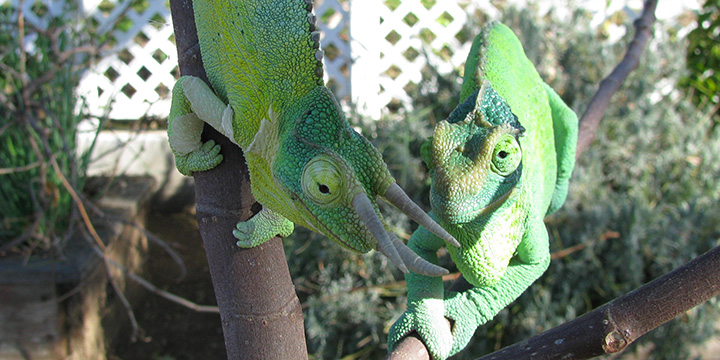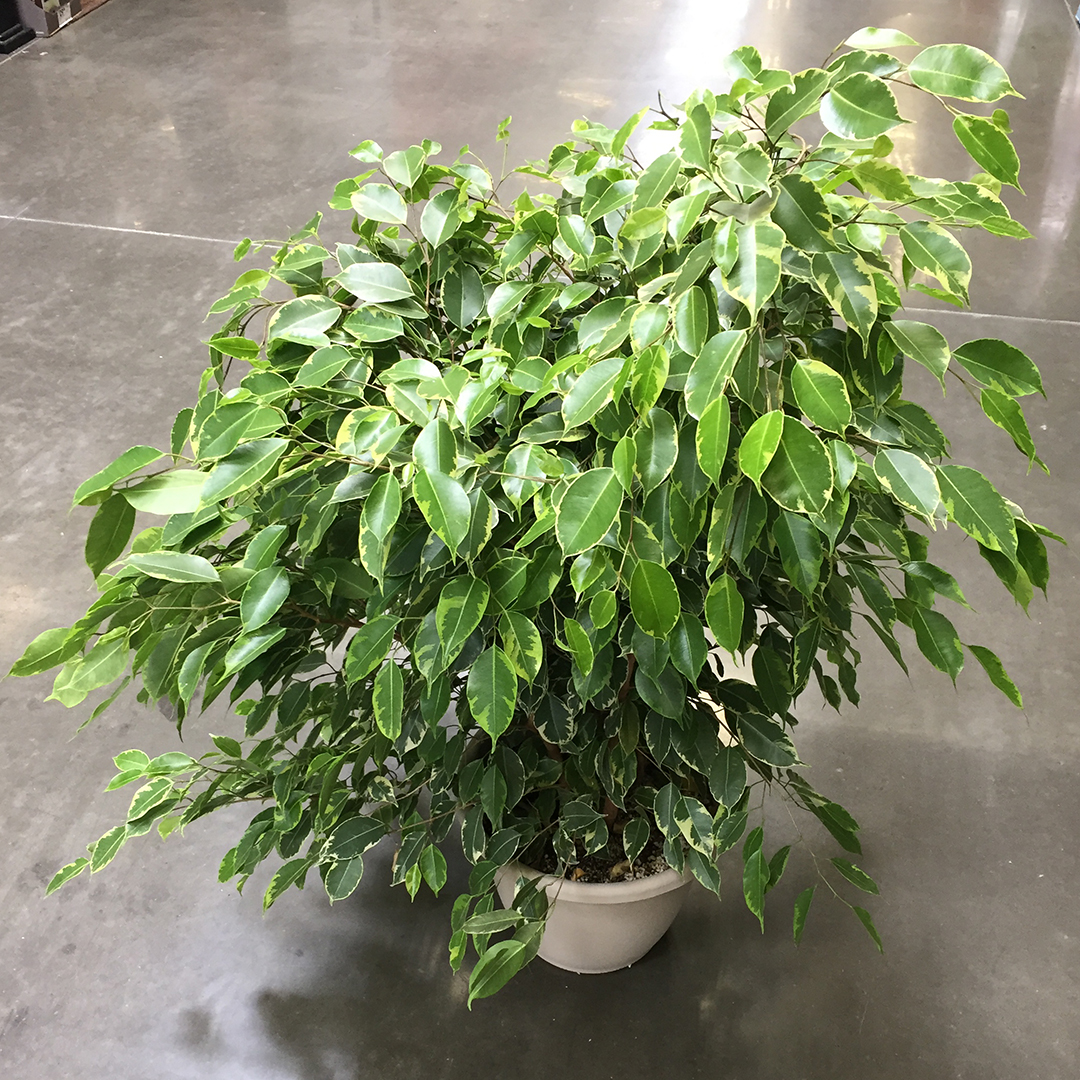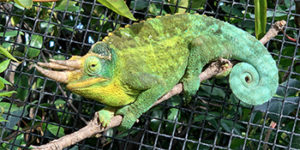Caring for Newborn Jackson’s Chameleon Babies
Introduction
Chameleons are our modern day dragons and Jackson’s Chameleons are our most dinosaur-like of these mini-tree dragons. With their ability to give live birth we can be surprised, but experienced Jackson’s Chameleon keepers know that it is worthwhile to always have fruit fly cultures and bean beetles on hand – just in case. This care sheet reviews the basic of Jackson’s Chameleons baby care. But we will start with the mother. We need to make sure she is in optimal health as that is the prerequisite for having healthy babies to raise.
Signs Your Jackson’s Chameleons Female is Pregnant
There are times when it is obvious when your female Jackson’s Chameleon is pregnant. The tell-tale rotund belly makes it no question that there are babies on the way. But there are times when the litter will be small and you wonder what is really going on. The safest assumption to make is that your female is pregnant. They have the ability to store sperm and impregnate themselves at their body’s choosing. This makes it extra-ordinarily difficult to predict when babies will arrive.
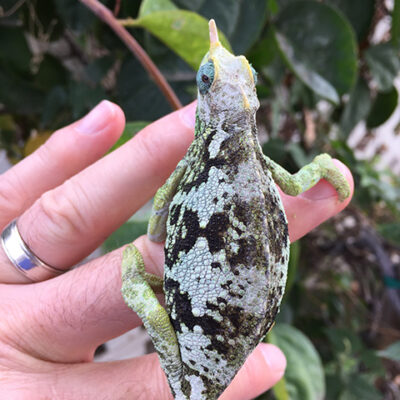
This female Mt. Meru Jackson’s Chameleon (Trioceros jacksonii merumontanus) is showing the rotund body shape indicating she is pregnant.
Podcast: The Jackson's Chameleon Pregnancy
This podcast episode talks about the time period that the Jackson’s Chameleon is gravid. I go over the signs you should look for during this development time.
Preparation
Female Jackson’s chameleons are best kept in cages with mesh no greater than ¼” squares. Of course, this is not for her need, but it is so a surprise litter being born does not quickly disperse into room or garden! The mother should be fed a varied diet of gutloaded and supplemented insects. Her health will directly influence the health of her babies. Ensure she has a good balanced supply of calcium, D3, and magnesium to keep Metabolic Bone Disease away. A UV Index around 3-6 will give D3 through UVB. But if this is not available then a supplement with calcium and D3 is critical. Access to natural unfiltered sunlight does chameleons, especially Jackson’s Chameleons, a world of good. Make the extra effort to give pregnant females this opportunity.
Signs your female is about to give birth
The female will eat heartily during pregnancy, but slow as her body cavity fills up with babies. The tell tale sign that birth is within days is when she goes off feeding. It is when the keeper comes onto social media worried that their chameleon is not eating anymore that we advise to prepare for babies. On the day of the birthing, your chameleon may be restless.
Giving Birth
The birthing usually takes place in the morning hours. The female will deposit babies in various places preferring to spread them around. She usually wipes them off on a branch or side of the cage. Sometimes they escape their sac there and sometimes they will fall to the bottom of the cage. Do not worry about the fall to the bottom of the cage hurting them. They will break out of their sac and will quickly come to life. Their first instinct is to disperse. This is why when you first notice them, the babies are crawling up the sides of the cage instead of clumping in the bushes where it would be safer.
The mother will not eat her babies directly after giving birth. It seems as though there is an appetite suppressant that ensures the babies can disperse before being viewed as food by their mother. So when you see babies in with their mother you can remove them in a calm and orderly fashion. But definitely remove them as, soon after birth, your female will suddenly realize she is famished from this ordeal and from not eating in the last couple days. Don’t test the grace period any longer than you have to!
Caging
Any standard baby caging will suffice for Jackson’s Chameleons. Screen cages, ventilated glass vivariums, or even plastic tubs can be used. Ideally, each baby would have their own cage space, but they can be kept together with adequate space and resources for about three months under your watchful eye. An effective cage example would be a standard screen cage with a network of thin branches and dense, leafy, live plants. The more chameleons you pack into the cage the more branches and leafy hiding places you will need to ensure that each baby has what they need as far as resources.
Cage size can be to your comfort level. I successfully kept eight babies in a heavily planted 48” tall cage. I have multiple feeding stations and basking areas and I trust them to take care of themselves – which is what they are designed to do! But smaller cages, where they can be more supervised, are usually used and effective as well. Cage size is important, but how you fill the cage is the true test of how many babies can temporarily co-exist in relative peace. The more babies you have in a cage the more dense the leaf cover must be. The key to successful group raising is to provide a great deal of privacy opportunities. With enough space, dense plant life, and ample ways to be out of each other’s visual way, babies can be raised together. As much as I say individual raising is ideal, it is difficult for just about all of us to do and a great deal of work. A litter of 40 babies will be beyond what the standard breeder can handle. I will not say it is best to raise them together, but I will say that with enough plant cover and equal availability of the basics for life it is not an issue until your babies start getting it in their head to establish territory. Once that happens the gray area is over and co-habitation is a very bad idea.
My personal approach is to have a bank of 48″ planter box cages which are heavily planted. These are where I keep my female babies between 0-6 months in small groups up to four individuals. At three months of age I put males individually into their own screen cages. There really isn’t a way to reliably house males together. Regardless of our limitations as breeders, they need to be separated. It is our responsibility to provide them with this separation. Breeders of Jackson’s Chameleons have the added challenge of how long we are needing to hold on to our babies before selling them. If we have chosen the Jackson’s Chameleon as our species project then this is the challenge we must accept. This is also why a serious breeder of Jackson’s Chameleons is a rare find and will be producing a superior quality baby.

A cage bank for housing baby Jackson’s Chameleons
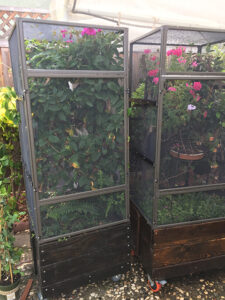
Outdoors planter box cages can be made to be heavily planted and provide a great home for Jackson’s Chameleons.
Of course, you can get as fancy as you wish! This is an all-out set-up for a baby Jackson’s Chameleon!
Plants
Plants create the life in the vivarium. They form the function of providing water drinking surfaces, hiding places, and the creation of humidity pockets through transpiration and their soil.
Place perching branches so that drinking water from the leaves is simple. As babies they will use the leaf edges as climbing highways so branches may not be used much, but as the chameleons grow they will, more and more, prefer branches so I would start with them anyways.Luckily, the most common plants available to us from standard home improvement stores and nurseries are perfect for baby cages. Schefflera arbicola, the Umbrella plant, is a popular choice for a plant in a baby cage as its leaf structure consists of the pinwheel design with each one of the “spokes” being a perfect baby perching “branch”. Ficus benjamina, with its typical fine mesh of tiny branches becomes perfect for perching spots. Epipremnum (also known as Pothos) is less suitable for climbing, but is excellent for quick creation of many areas of visual isolation.
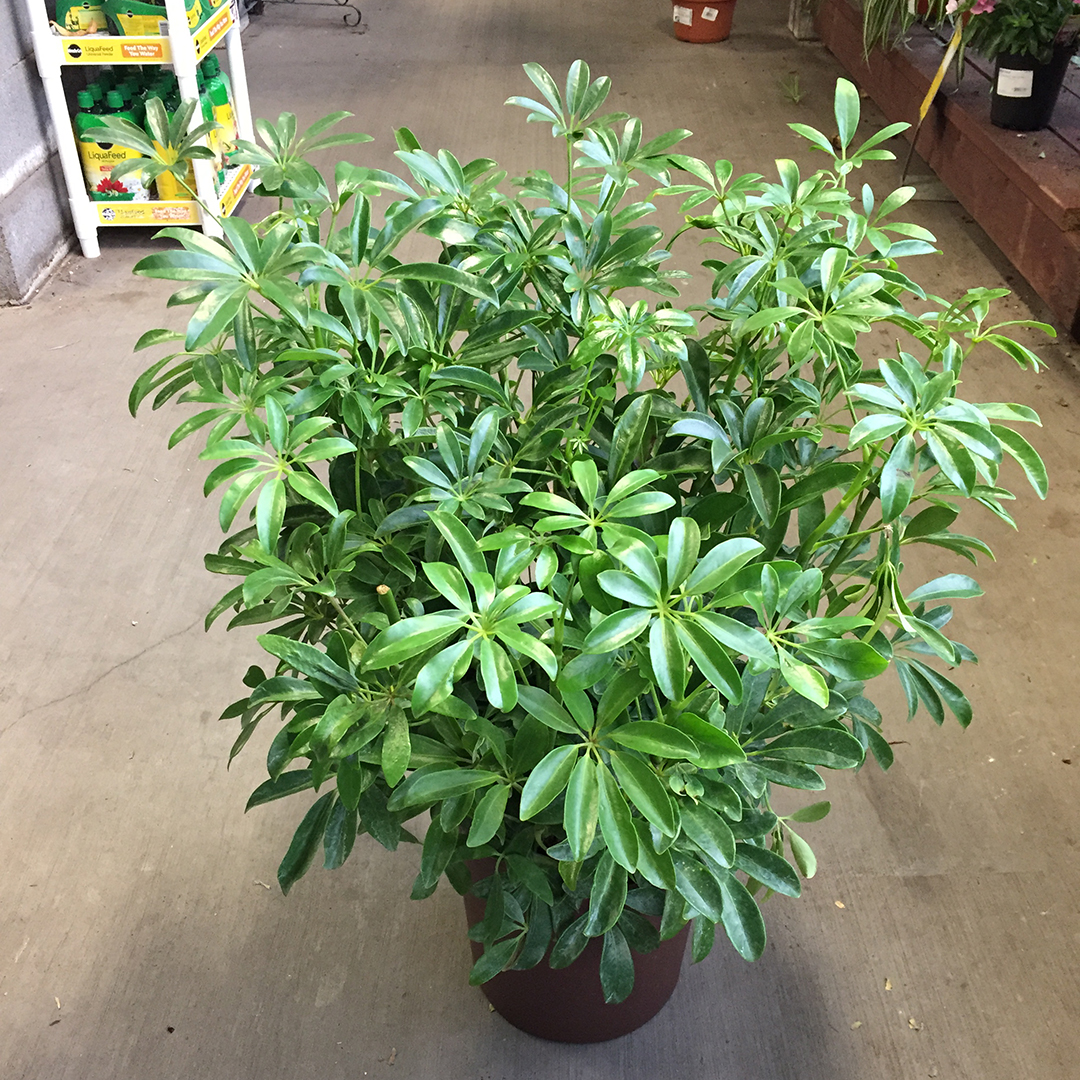
The Umbrella Plant (Schefflera arboricola)
Branching
Any fine sticks will suffice. Luckily, all the leaf edges in the cage will also provide perching surfaces in the earliest of days! Unless there are known chemicals, cleaning and baking wild branches is unnecessary. There are those that will emphatically insist that the branches must be disinfected for the safety of the babies. As long as your disinfection/cleaning method does not introduce chemicals that are worse than whatever you are concerned about from the wild then there is no harm in cleaning branches. But, in decades of personal experience in collecting branches from just about anywhere in the suburban environment I can relate that there has never been an issue – chemical, parasitic, or micro/macro organism – that would be tied to a wild branch. That said, make sure you are not bringing in spiders. A typical black widow can easily trap and kill a baby chameleon.
Hydration
In the wild, Jackson’s babies will be exposed to high nighttime humidity and lower daytime humidity. Their daytime low humidity will be lessened due to the thick vegetation they stay in. This is due to being close to the soil and to transpiration (the plants releasing moisture into the air.)
Babies need special consideration when it comes to hydration. They are small and our mechanical misters can be overwhelming. Babies are programmed to disperse so it is not unusual to find them trekking across the bottom of the cage and puddles of water can be a drowning danger. So, as with so many things, the operative word with babies is “gentle”.
Your basic template is high humidity during the night, dew in the morning, a slow, but constant drip during the day, and an occasional afternoon rain shower. I will present a simplified view of this, though I acknowledge that some breeders take it even further to its most simple form. They use a hand sprayer to spray down the cage surfaces a couple times a day and this fulfills the bare basics. Cheap and easy. But I would not be doing my dedication to wild re-creation if I left it at that.
To recreate their wild condition, I would use an automatic misting system programmed to go off for 30 seconds about 15 minutes before the morning lights come on. This lays down a layer of dew for them to wake up to. I then start a slow drip from a dripper (or a pin prick at the bottom of a plastic party cup) sometime in the morning. Three times a week I have an afternoon rain shower where I turn off the heat lamp, wait 15 minutes, turn on a fogger to cool the area (not critical, but a nice touch), run the mister for a minute, turn off mister and fogger, and then, only if necessary, turn the heat lamp back on 15 minutes later. You will notice that I measure everything in increments of 15 minutes. The only thing magical about that time length is that is the usual resolution on the standard home appliance timer. Once the lights go off I wait another 15 minutes and run the mister another 30 seconds to lay the foundation for a humid night. Anytime between lights out and midnight I have an ultrasonic humidifier start running to fill the area with fog. The idea is that between midnight and 5AM you simulate a fog bank rolling in. High humidity at night is important to decrease or even reverse hydration loss from breathing. What is critical, though, is that all this high humidity and moisture dissipates in the morning and the cage is dry during the day. For babies, a daytime humidity around 50% is fine. But surfaces must dry out to avoid health issues.

Drainage
The other side of hydration is drainage. Where does the unused water go? Usually this is done by a drainage tray that the cage sits on or by a gutter structure that the cage drains into. The basic consideration for drainage is that the excess water must be collected outside the cage. Cheaper cages will have only substrate trays available for them. Substrate trays go inside the cage and are unsanitary unless you are creating a bio-active environment with a soil layer. Otherwise you are creating an unappetizing soup. The last thing you want to do is have your water trapped at the bottom of your cage to mix poop and escaped feeders together to create a sanitary nightmare.
Feeding
Babies have some food reserves when they are born so do not be concerned if they do not eat right away, but I usually see them eating within 24 hours. Fruit flies are the ideal baby chameleon feeder due to their relatively cheap breeding setup and the soft-bodied, active bodies. T. j. xantholophus and the larger T. jacksonii jacksonii can eat the larger flightless fruit fly, Drosophila hydei. T. j. merumontanus babies are very small and so Drosophila melanogaster would be appropriate.
Give as much variety in feeders as possible. It is difficult to find many varieties commercially available, but you will be able to find fruit flies, pin head crickets, and bean beetles. If you have enough time to prepare you can breed superworms and feed the newly hatched “worms”.
If you are in an area that has naturally occurring fruit flies then you have a very easy supply of food available. Leaving a cup of banana or other fruit will soon attract the flighted fruit flies and a network of branches nearby will provide multiple feeding stations. Be careful that the chameleons have easy tongue access to all areas of the fruit bowl via branches so they do not feel the need to crawl over the fruit to reach that one perfect fruit fly that has caught their eye.
As with adults, view each feeder as a nutrition packet going into your chameleon. Especially now, each baby needs the best nutrition available. Make sure whatever you are feeding your babies has been properly gutloaded. This can be done simply by offering your crickets or superworms a variety of fruits & vegetables like carrots, oranges, apples, squash, collard greens, and sweet potatoes. Bee pollen, spirulina, alfalfa, and kelp/seaweed are excellent foods I include whenever possible. Commercially available gutloads are also available and I offer these on a separate plate alongside the fresh ingredients.
Supplementation
You can use the same supplementation you do with adults. Jackson’s Chameleons tend towards developing edema (excess fluid retained) easily which eventually seems to resolve itself with a decrease in supplementation. One possibility is too much of a certain vitamin or mineral and another is simply an imbalance of the vitamins & minerals in the relative amounts they are provided in the supplements. I, personally, have been using Arcadia EarthPro-A as my main supplement for both my indoor and outdoor Jackson’s with a weekly use of Repashy Calcium with Lo-D for my indoor chameleons. Please remember your hydration. It takes water to digest – especially when we add dry powder to the diet.
Lighting
The sun provides light to see, light to warm by, and light to synthesize vitamin D3. Just remember that that the smaller the space the more careful you will have to be in the energy you put inside.
Light to see: T8 6500K fluorescent bulbs are an inexpensive and readily available light source. T5 size bulbs are also available, but will produce heat. This is significant if you are using an enclosed vivarium to house your babies. Heat builds up and you may find it easier to keep your parameters adjusted if you separate your daylight generation from your heat generation. In a well ventilated cage or larger cage this becomes much less an issue.
Light to warm by: All chameleons will want to warm themselves to get a start in the morning. Since we strive for a definite night drop in temperature during the night, your Jackson’s will want to warm up in the morning. But Jackson’s chameleons are a cooler weather species and warming up means into the high 70’s. So a moderate heat lamp is appropriate. These are babies so a little heat goes a long way. If you are keeping a litter together then have a large reflector so the heat goes out over a wide area that has multiple perching branches. Make the access to a brief morning warm up as equal to all perching spots as possible. If you have eight babies then have eight equal basking spots. This may be easier by having two basking lamps on either side of the bin or cage. You will want a gentle heat and the basking spot can be in the low 80s. Beware of the top of the cage getting too hot. Babies are often found crawling on the screen top of the cage. Ensure that they cannot burn themselves by doing this. This means that resting a heat lamp on the cage top is a risky strategy. Chameleons are smart and will avoid pain, but their internal instinct is not programmed to understand thermal burns from the sun. They get into the sun to warm up and go back into the foliage when up to the right temperature. There is no being “too close” to the sun possible in nature.
Light to synthesize vitamin D3: There is a small band of wavelengths within what we have classified as the UVB range that chameleons and other vertebrates (including humans) use to synthesize vitamin D3 which is critical in processing and using calcium. Here is where advice gets difficult. The most precise advice I can give is to produce at least a UVI of 3 at the basking spot. You’ll be able to measure UVI 3 if you have an expensive Solarmeter 6.5 (or equivalent). While this is a worthwhile tool to be in any chameleon keeper’s toolbox, relatively few people have them. Here is the problem: each UVB bulb puts out a different amount of UVB depending on brand, strength, size, and even age of the bulb. And then the strength of the UVB decreases if you have it going through a screen cage top or even if you have it in a fixture with other bulbs. So I can give only general advice. If your UVB bulb is within six inches of your perching spot then I suggest using a T8 Reptisun 10.0 style bulb. If you can be above six inches, an Arcadia T5 6% or Zoomed T5 5.0 bulb would do. Obviously, there is much variation in what UVB will be present. The balancing component to this is the same as with heat – give your chameleon ample opportunity to escape in the form of dense leaf cover below the UVB basking branch. For all the fervor in the community over UVB strength it appears chameleons can accept a wide range and function. Basically, your chameleon soaks up UVB through its skin and uses it to synthesize vitamin D3. It needs to be at the proper temperature to do this so the basking bulb is important. Once the chameleon has all the UVB they need their body starts blocking the UVB. On the other side, there is also a limit to how much UVB the body can withstand before it burns. We humans do this too. Vitamin D3 is why we need to get unfiltered sun exposure and also why we get sunburns when we get too much. The key for you as the cage set-up artist is to have a basking area with UVI 3 and then thick foliage for the chameleons to retreat back into to escape the UVB. This is how they live in nature and this allows them to make the choice as to how much UVB they are exposed to. It is not unreasonable that they have the same biological feelings of “wanting to get out of the sun” as we do. Give them that opportunity and let them regulate their exposure on their own.
Outdoor keeping
If you have weather that is sunny during the day then consider giving your babies natural, unfiltered sunlight. It is amazing how easy Jackson’s Chameleon husbandry gets when they are able to be kept outdoors. There is something subtle that natural sunlight and conditions create that are difficult to reproduce in captivity. Of course, there is great danger outdoors as well if your cage is built for indoors. The sun is life giving, but is also merciless and will kill your babies within hours if this is not done properly. But doing it properly is not hard. You approach the situation just like you did with your indoor set-up. Figure out your gradients. The difference is that you have a much more powerful, but more constant source of energy.
Making permanent outdoor caging is another topic. So let’s talk about just an afternoon outdoors. You can bring your indoors cage and place it outside as long as you make sure that the sun will not cook it. There is UVB in shade as well so the benefit is not lost. The smaller the cage the more careful you must be. In my 48” cage I can place it so half is in the sun and half is in the shade. Then the babies can choose. If you have a smaller cage then you have less freedom to just put the cage outdoors. Regardless of cage size, you need to keep an eye on any outdoors exposure. The sun moves. Make sure your babies are safe no matter where the sun goes in its path.
Selling Babies
There will come a time when you will want to find new homes for your babies. Jackson’s Chameleons are a little more tricky than veileds or panthers. Jackson’s Chameleons tend to be sensitive until closer to six months in age. They grow slower and there are traditionally problems with them dying off between four and six months. This sudden die off is a mystery at this time, though we are working to figure out what causes it. It is definitely a husbandry issue, but without a consistent event it is difficult to pinpoint. Some people encounter it and some people don’t. Is it the effects of co-habitation? Is it nutritional? The answer is to be determined. The point of bringing this up is that, at this point, it is safest to wait until between four and six months before sending them off to their new home.
This puts the Jackson’s Chameleon breeder in a touch spot. Jackson’s should be separated long before the six month mark and not a lot of people have enough cages to raise babies up individually. A possible compromise is to separate out males and keep females together. You will have to plan for this and work with the conditions you have.
Conclusion
Having Jackson’s Chameleon babies is a joy. They are a lot of work to set up for, but once the set-up is complete, they do mostly take care of themselves! Their slower growth does give us a challenge, but there is little that can replace joy of watching those horns grow in and those lime or lemon greens coming out of the cryptic baby patterns.
Navigation
This seminar is part of the Jackson’s Chameleon Profile.

